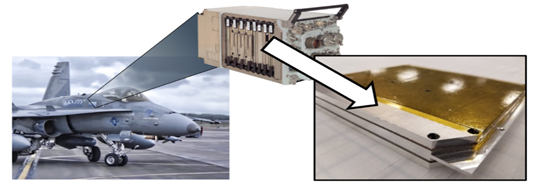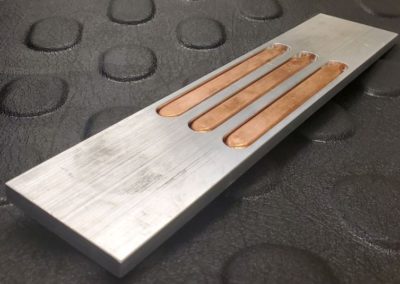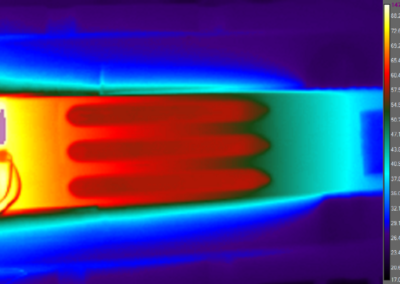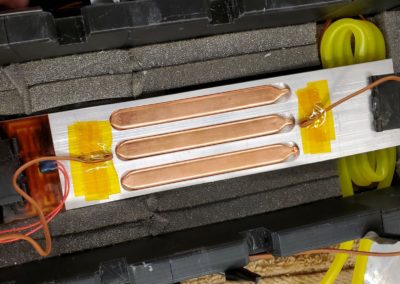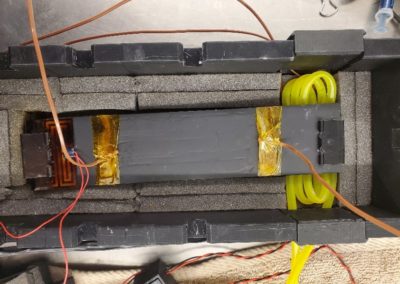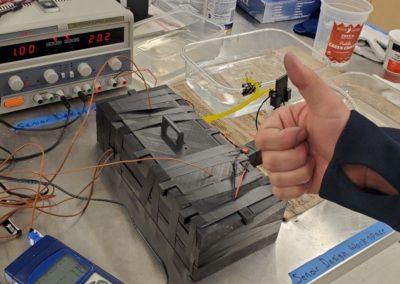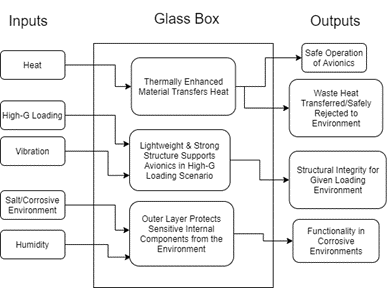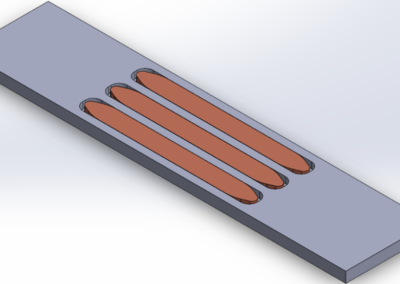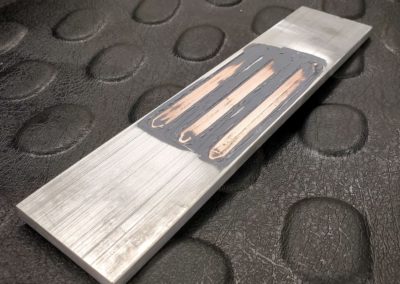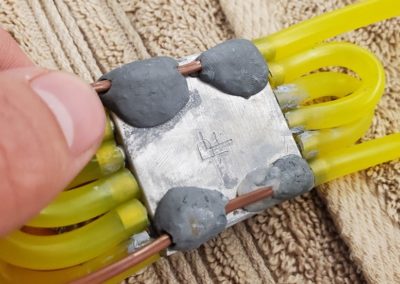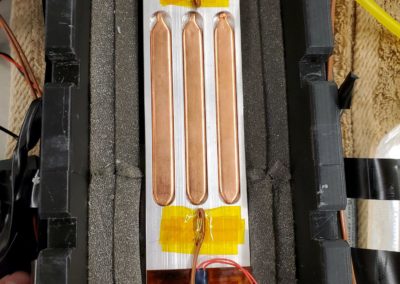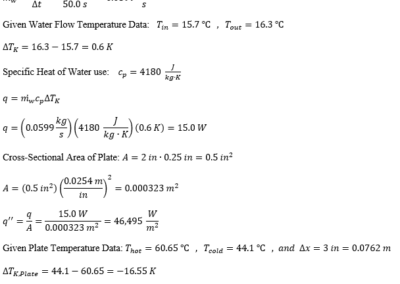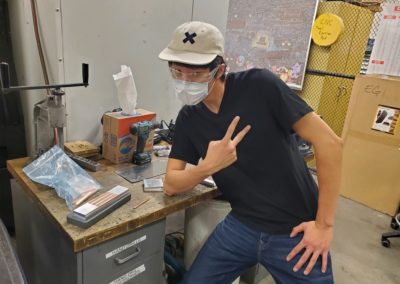Manufacturing Improvements for Military Aircraft Avionics Cooling Chassis
Overview
Increased data processing and power consumption in modern aircraft computing has driven increased heat build-up in avionics components which can damage the electronics necessary for mission success. These heat loads must be dissipated rapidly to allow for component longevity and proper operation in a wide array of service environments including humidity, salt corrosion, shock, and vibration. The Military Avionics Cooling Chassis at Mines team (MACCAM), working together with client, Dr. Mario Saldana of Roccor set out to develop an improved design and method of manufacture for avionics cooling chassis structures in the Spring semester of 2020. Significant research into heat dissipation methods and their respective manufacturing processes was required. In addition to design prototyping, a thermal test method and apparatus that could accurately determine thermal performance was needed. Thus, the nature of this project consists of two main components: (i) prototype design, and (ii) development of a thermal test bench to determine thermal performance of prototypes.
Our final design prototype achieves an improvement in thermal performance of 13 to 25 times the benchmark (6061-T6 aluminum).
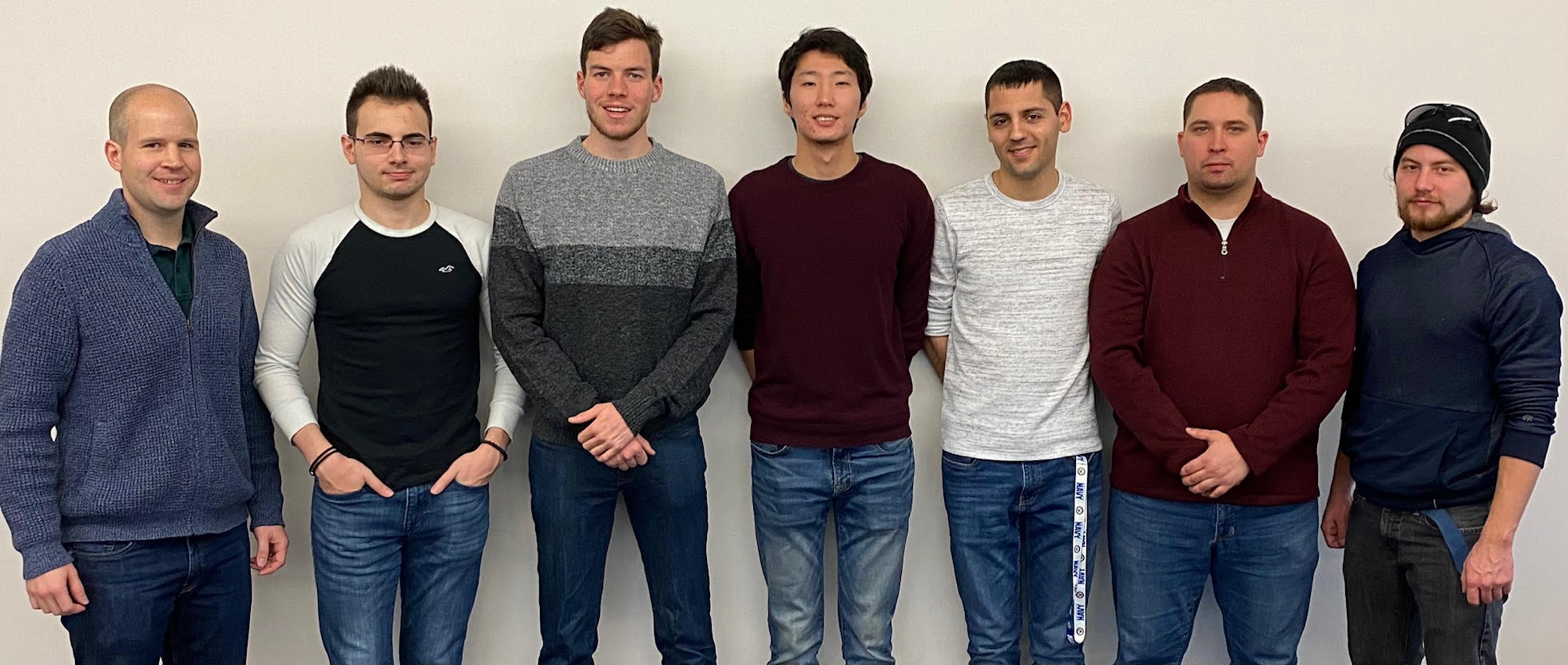
Live Zoom Call
Use the link below to join us live from 8:00 – 10:30 a.m. on December 3.
Please use passcode: 099710
Or iPhone one-tap: 13462487799,98172661061# or 16699006833,98172661061#
Or Telephone:
Dial: 1 346 248 7799 (US Toll) or 1 669 900 6833 (US Toll)
Meeting ID: 981 7266 1061
Team Members
- Nicholas Navarro
- Nick Mulay
- Ryan Frederickson
- R. Cole Miller
- Erchis Erdenebat
- Zack Amatelli
- Greg Duncan
The Client
- Dr. Mario Saldana, (Roccor)
Acknowledgements
Project Advisor: Prof. Antonie Vandenberge
Technical Advisor: Dr. Jason Porter
Huge thanks to Roccor for their sponsorship. To Dr. Mario Saldana for being a wonderful Client. Professor Jason Porter as our Technical Advisor. Professors Hommer and Mahoney for use of ADAPT Lab. Emily Sievers for assistance with procurement. And Professor Antonie Vandenberge, our Project Advisor. We could not have done it without you!
Elevator Pitch
In aeronautics and space, having efficient heat transfer can be the difference between success and failure. Here at Mines, we are pioneering cutting edge technologies and exploring new ideas to make tomorrow’s problem a thing of the past.
Thanks to our partnership with Roccor, we have been able to pursue this challenge past many obstacles, allowing us to create a solution to transfer heat more effectively than ever before.
Design Approach
Throughout the project timeline, MACCAM utilized an iterative design approach in concept development. The stages of this approach include research, plan of design, physical build, testing, and finally iteration. The primary driver for our prototype iteration was improved thermal performance beyond what pure aluminum is capable of itself. The thermal objectives of our design are derived from the heat conduction equation where increased thermal performance results from: (i) smaller temperature gradients in the direction of heat flow, and (ii) a lower maximum temperature once the system reaches a steady-state condition.
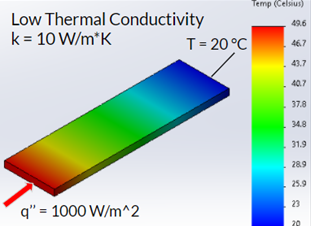 Lower thermal conductivity results in a larger temperature gradient and a higher steady state temperature. (Lower thermal performance) |
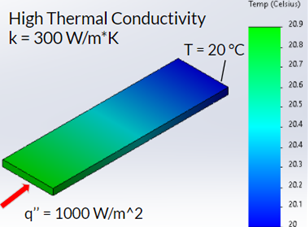 Higher thermal conductivity results in a smaller temperature gradient and a lower steady state temperature. (Higher thermal performance) |
The first semester of the project (Spring 2020) was spent mostly in a research study where three unique heat dissipation mechanisms were considered: (i) embedded heat pipes, (ii) oscillatory heat pipes and (iii) annealed pyrolytic graphite.
The embedded heat pipe design allows for diffusion of heat away from its source, lowering the temperature of the surface and cooling the sensitive electronics that are attached. Inside the heat pipes, liquid is vaporized into a gaseous state, where it then travels down the length of the pipe in an isolated core. Once cooled, it condenses back into liquid and flows back to the heat source at a lower temperature.
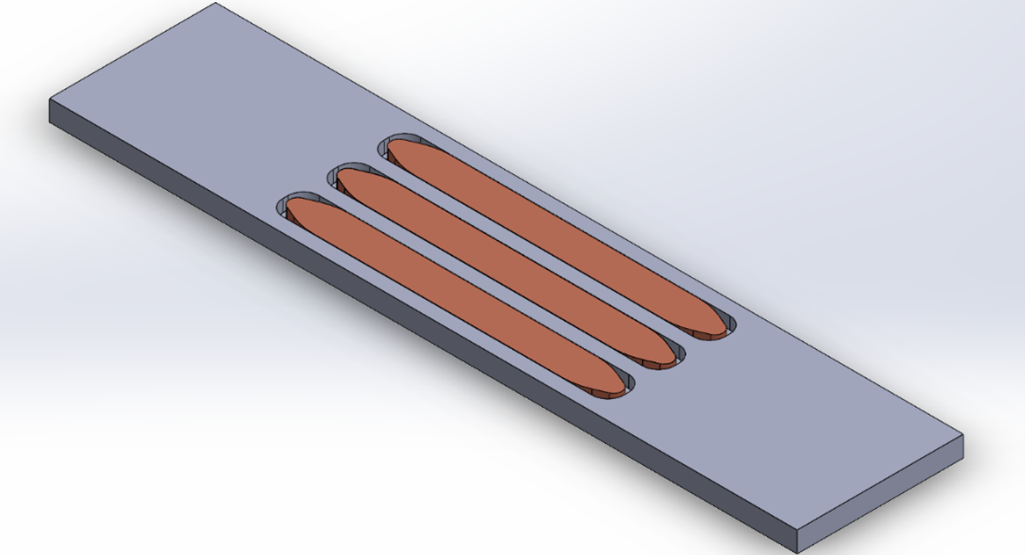 Embedded Heat Pipe Concept Rendering |
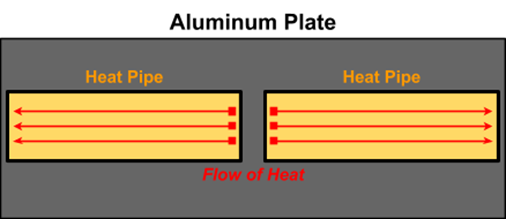 Visual representation of heat flow |
The Oscillatory Heat Pipe (OHP) takes the concepts of the regular heat pipe but applies a specific geometry to allow heat flow in a continuous oscillatory manner. It operates in a similar manner to the regular heat pipe except the working fluid is separated by a liquid slug and a vapor plug. An oscillation of the working fluid begins to transfer heat through the liquid slug. One major advantage of this design is in the application of micro-gravity, as theoretically the OHP is gravity independent resulting from the internal pressure flow pattern. This means OHP can be utilized effectively in a vacuum such as exists in space.
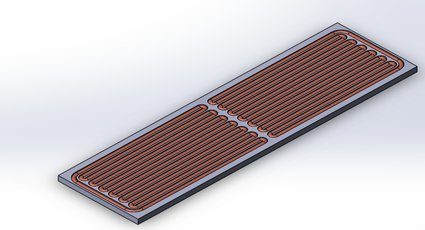 Oscillating Heat Pipe Rendering |
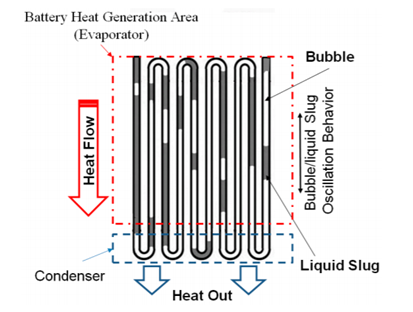 Oscillating Heat Pipe Concept Diagram |
Pyrolytic graphite are crystallized graphene sheets with varying degrees of graphene nucleation. Annealed pyrolytic graphite (APG) is highly anisotropic which makes it more thermally conductive in the cleavage plane than the layered orthogonal direction. One design solution with APG involves placing the layers in an orthogonal direction to the heat source. A distinct advantage of using APG rather than heat pipes is that there is no liquid involved in an APG design. Under high enough heat loads, heat pipes can easily burst if the vapor pressure exceeds the heat pipe structural limit.
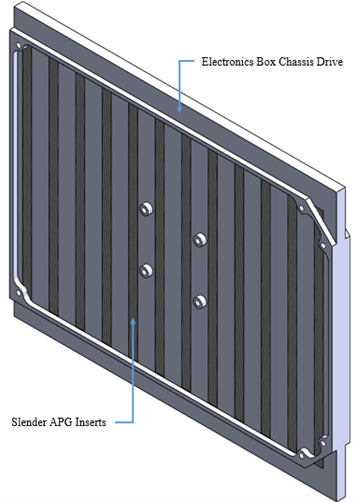 APG Concept Rendering |
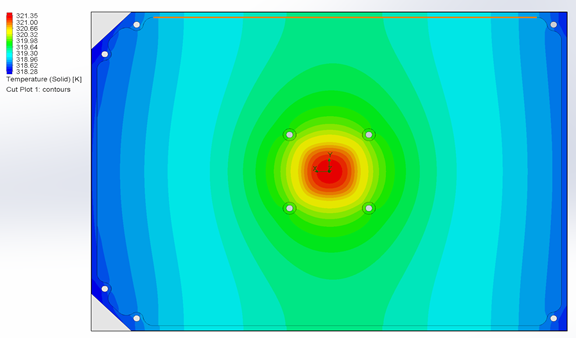 Solidworks thermal simulation (heat source centered) |
To determine thermal performance and verify our design solution, an insulated enclosure was built to house our prototypes and limit heat loss during test. Inside the enclosure, a commercial heater is fixed on one end of the test specimen and a water-cooled cold plate is fixed to the other end. Thermocouples are used to record the inlet and outlet water temperatures of the cold plate. In addition, two thermocouples are placed along the test specimen—one near the heater and the other near the cold plate. These four temperature readings, along with the measured mass flow rate of water through the cold plate are used to determine the effective thermal conductivity of the specimen. Higher conductivity values indicate better thermal performance.
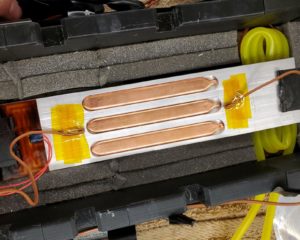 Test apparatus showing specimen inside enclosure. Heater attached (left); cold plate attached (right). Thermocouples held in place with Kapton tape. |
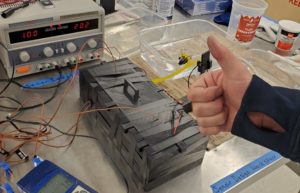 Thermal test enclosure fully sealed. Showing water reservoirs, variable power supply, and thermocouple card reader. |
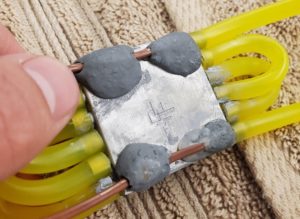 Cold plate design showing thermocouples attached. Thermocouples placed directly in water flow. |
Design Solution
In April 2020, the embedded heat pipe design was chosen as the go forward path based on stakeholder feedback from the Preliminary Design Review. One significant factor in this design selection was the fact that Roccor has developed their own high-performance, proprietary heat pipes and is looking to utilize them in structures such as those being developed for this project.
MACCAM’s design solution is ¼” thick and utilizes commercial off-the-shelf (COTS) heat pipes embedded within an aluminum plate. Slots are milled into one face of the aluminum to accommodate insertion and bonding of the COTS heat pipes. Use of epoxy to bond the heat pipes to the aluminum was found to improve thermal performance by reducing contact resistance at the interface of the aluminum and heat pipe. Indium solder was also explored as an alternative bond method to epoxy, however the final prototype delivered to Roccor features an epoxy bond (thermally conductive adhesive).
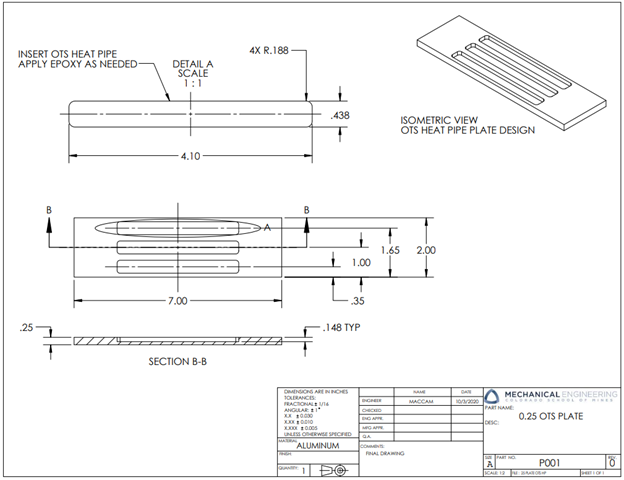
Final Prototype Drawing
To determine the thermal performance of our final prototype, three types of thermal test specimens were physically tested so that results could be compared:
- Plain 6061-T6 Aluminum (for calibration)
- Loose Off-the-Shelf Heat Pipes Embedded in Aluminum
- Off-the-Shelf Heat Pipes Embedded in Aluminum with Epoxy Bond
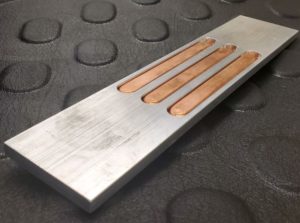 Loose COTS Heat Pipe Specimen |
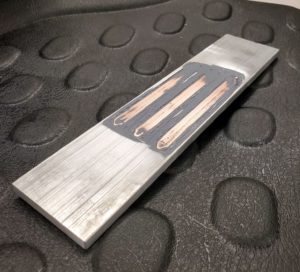 Epoxied COTS Heat Pipe Specimen |
The plain aluminum test results were compared with literature conductivity values. Experimental results were within an acceptable range of theoretical values which verified the accuracy of our test bench. Next, a specimen with loose COTS heat pipes was tested. Thermal performance was improved compared to plain aluminum, as predicted. Lastly, the final prototype featuring an epoxy bond was tested. Thermal performance was found to improve when compared to the loose COTS heat pipe specimen. Below are graphs of data collected for each test specimen. Improved thermal performance can be seen as a lower steady state temperature on the hot side, as well as a smaller temperature difference between hot and cold side. The epoxied heat pipe specimen is seen to have the best performance.
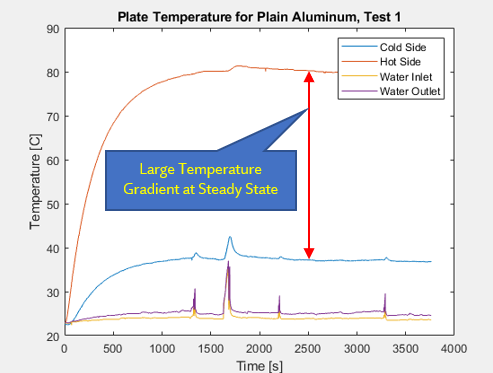 Plain Aluminum Test Graph |
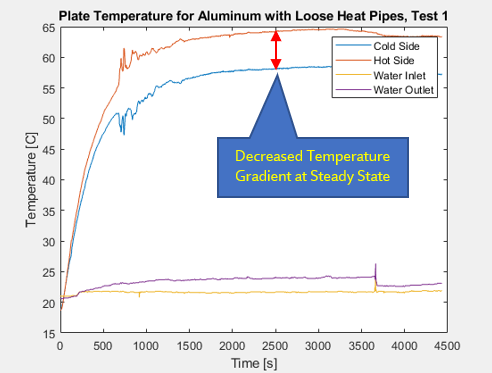 Loose COTS Heat Pipes Test Graph |
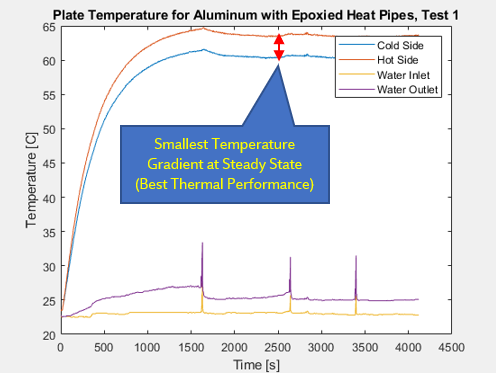
Epoxied COTS Heat Pipes Test Graph
The range of experimental thermal conductivity values for each test specimen are as follows:
- Plain Aluminum (6061-T6): 165 – 220 W/m*K
- Loose COTS Heat Pipes: 300 – 2200 W/m*K
- Epoxied COTS Heat Pipes: 2200 – 5600 W/m*K
The final prototype (Epoxied COTS Heat Pipes) achieves an improvement in thermal performance of 13 – 25 times the benchmark (6061-T6 Aluminum).
Next Steps
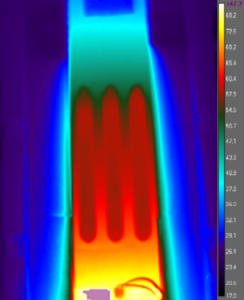 A functional prototype at ¼” thickness will be delivered to Roccor along with all the components required to run MACCAM’s thermal test bench. If a future team at CSM were to take over this project, MACCAM recommends further research into the solder bond method of embedding heat pipes into aluminum. Additionally, MACCAM advises future teams to conduct testing in the following areas: temperature change, shock load, vibration, high g-force, humidity, and salinity. Performing these additional tests would further characterize the performance of a design in service environments aboard military aircraft and space missions. These are the tests that our team was unable to do but are needed to verify that this project will work as desired. Should a failure occur during testing, a post-test analysis should be performed to identify the cause of failure and necessary changes to the prototype. Lastly, future work should involve a thorough study of manufacturing methods suitable for a large-scale production quantity.
A functional prototype at ¼” thickness will be delivered to Roccor along with all the components required to run MACCAM’s thermal test bench. If a future team at CSM were to take over this project, MACCAM recommends further research into the solder bond method of embedding heat pipes into aluminum. Additionally, MACCAM advises future teams to conduct testing in the following areas: temperature change, shock load, vibration, high g-force, humidity, and salinity. Performing these additional tests would further characterize the performance of a design in service environments aboard military aircraft and space missions. These are the tests that our team was unable to do but are needed to verify that this project will work as desired. Should a failure occur during testing, a post-test analysis should be performed to identify the cause of failure and necessary changes to the prototype. Lastly, future work should involve a thorough study of manufacturing methods suitable for a large-scale production quantity.
Meet the Team
Greg Duncan
 Greg is a graduating senior in mechanical engineering. His interest in thermal/fluid systems and their application in aerospace engineering is what initially interested him in this project. He served as communications lead and product owner for the team through both semesters of the project. After graduation, Greg will continue working in the aerospace industry as a mechanical engineer at Lockheed Martin.
Greg is a graduating senior in mechanical engineering. His interest in thermal/fluid systems and their application in aerospace engineering is what initially interested him in this project. He served as communications lead and product owner for the team through both semesters of the project. After graduation, Greg will continue working in the aerospace industry as a mechanical engineer at Lockheed Martin.
Nick Navarro

Nick is a graduating senior in the mechanical engineering department. He is the Project Manager for this project and has a keen eye for leadership. Nick is always willing to take charge and get tasks done. His interests include robotic systems, mechatronics, and aerospace engineering which influences his everyday thinking and activities. He will be continuing his engineering journey at Lockheed Martin where he hopes to make a difference in mechanical systems venturing to Space.
R. Cole Miller
 Cole is a graduating senior in electrical engineering with a specialization in radio frequency engineering. Cole has a background working as a nuclear engineer in the U.S. Navy and worked as the scrum manager for this project. His interests include figuring out how things work, hiking, biking and playing games with friends. After graduating, Cole will continue working with the Navy as he joins the Naval Air Warfare Center Weapons Division at China Lake.
Cole is a graduating senior in electrical engineering with a specialization in radio frequency engineering. Cole has a background working as a nuclear engineer in the U.S. Navy and worked as the scrum manager for this project. His interests include figuring out how things work, hiking, biking and playing games with friends. After graduating, Cole will continue working with the Navy as he joins the Naval Air Warfare Center Weapons Division at China Lake.
Nick Mulay
 Nick is a graduating senior in mechanical engineering with a minor in physics and worked as the assistant project manager. His interests include reading, both fiction and nonfiction, exercising, video games with friends and outdoor activities such as running and hiking. After graduation Nick will serve in the U.S. Navy as a nuclear engineering officer in the submarine fleet, where he plans to broaden his engineering and leadership skills.
Nick is a graduating senior in mechanical engineering with a minor in physics and worked as the assistant project manager. His interests include reading, both fiction and nonfiction, exercising, video games with friends and outdoor activities such as running and hiking. After graduation Nick will serve in the U.S. Navy as a nuclear engineering officer in the submarine fleet, where he plans to broaden his engineering and leadership skills.
Erchis Erdenebat
 Erchis is a graduating senior in the spring of 2021, in mechanical engineering with a minor in energy. He is in charge of the budget and to make sure the team does not exceed it. His strong background in thermal systems and mechanics interested him in this project. He has been working as a HVAC technician since his mid-teens, from starting out as a helper to now a journeyman tech. He is interested in space, the great outdoors, art, and mechanical systems. After graduating in May, he will continue to expand his HVAC knowledge in the construction industry.
Erchis is a graduating senior in the spring of 2021, in mechanical engineering with a minor in energy. He is in charge of the budget and to make sure the team does not exceed it. His strong background in thermal systems and mechanics interested him in this project. He has been working as a HVAC technician since his mid-teens, from starting out as a helper to now a journeyman tech. He is interested in space, the great outdoors, art, and mechanical systems. After graduating in May, he will continue to expand his HVAC knowledge in the construction industry.
Zack Amatelli
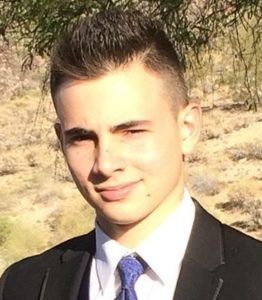 Zack is a graduating senior majoring in mechanical engineering and minoring in computer science. He worked as the team facilitator for this project. His interests include coding, aerospace engineering, and virtual reality technology. After graduation he will enroll into Officer Training School to start his career as an Air Battle Manager in the United States Air Force.
Zack is a graduating senior majoring in mechanical engineering and minoring in computer science. He worked as the team facilitator for this project. His interests include coding, aerospace engineering, and virtual reality technology. After graduation he will enroll into Officer Training School to start his career as an Air Battle Manager in the United States Air Force.
Ryan Frederickson
 Ryan is a graduating Senior majoring in Mechanical Engineering. He worked as a technical lead on this project. He is interested in 3D printing, woodworking, and running. After graduation, he will be working as an engineer at Roccor, the aerospace company that sponsored the project, where he will continue applying his engineering skills.
Ryan is a graduating Senior majoring in Mechanical Engineering. He worked as a technical lead on this project. He is interested in 3D printing, woodworking, and running. After graduation, he will be working as an engineer at Roccor, the aerospace company that sponsored the project, where he will continue applying his engineering skills.
